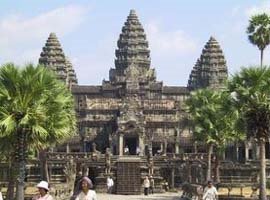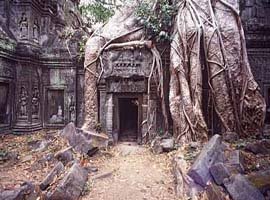Angkor Wat Cambodia Part 2
 The history of Angkor Wat Cambodia dates back to the kingdom of Funan. This kingdom was established by an Indian Brahmin, and in AD200, the country was peacefully settled by Indian traders. Four hundred years later, the kingdom had become a prosperous trading region. As the area was located on the Pilgrim rout between China and India, Hinduism and Chinese Buddhism was adopted by the new settlers.
The history of Angkor Wat Cambodia dates back to the kingdom of Funan. This kingdom was established by an Indian Brahmin, and in AD200, the country was peacefully settled by Indian traders. Four hundred years later, the kingdom had become a prosperous trading region. As the area was located on the Pilgrim rout between China and India, Hinduism and Chinese Buddhism was adopted by the new settlers.The Indian and Chinese influence can still be felt in Cambodia, and the temples of Angkor Wat Cambodia closely resembles Hindu and Buddhist temples that can be found in Northern India and in Nepal. In the end of AD600, the Funan Empire lost much of its power to the kingdom of Chenla. The capital of this new empire, Sambor, was located about 40 miles to the Southeast of Angkor Cambodia. During this time, beautiful sculptures and carvings in sand-stone was popular. In AD750, a king with a reputation of being a war-like person, who was able to expand the Chenla kingdom. However, trade with India stopped, and the Indonesian Empire raised to power.
 In AD800, the kingdom of Kambuja was established, and king Jayavarman I took control over the kingdom. He built several capitals near Angkor Wat Cambodia, were responsible for many social changes, and was able to size land to the North and to the East. In AD889, a nephew of Jayavaram became the new emperor, and he was able to bring peace and unity to the Khmer Kingdom. In AD944, Jayavarman V established many Mahayana Buddhist temples near Angkor Cambodia, and moved the court to Yasodharapura, at Angkor Cambodia.
In AD800, the kingdom of Kambuja was established, and king Jayavarman I took control over the kingdom. He built several capitals near Angkor Wat Cambodia, were responsible for many social changes, and was able to size land to the North and to the East. In AD889, a nephew of Jayavaram became the new emperor, and he was able to bring peace and unity to the Khmer Kingdom. In AD944, Jayavarman V established many Mahayana Buddhist temples near Angkor Cambodia, and moved the court to Yasodharapura, at Angkor Cambodia.Cultures prospered, and so did the Khmer empire. In AD1000, Suryavarman, a young man who may have come from the Malayan provinces of the empire, ascends the throne of Kambuja. He would become the king of Kambuja for over 50 years. He is responsible for the planning and foundations of the city of Angkor. In AD1051, Udayadityavarman II succeed Suryavarman, and continued to build the city of Angkor, and restored many of the temples. Angkor was now both a sacred temple city and the center of a vast irrigation system.
Massive expansion of the city continued throughout the next 200 years, and ambitious building programs expanded the city. Many temples were built. The temples are spread out over about 40 miles around the village of Siem Reap Cambodia. Temples and similar structures to the temples that can be found in the city of Angkor are common sights in Thailand, Laos, Vietnam and in China. Perhaps the most famous temple, Angkor Wat Cambodia, is a temple dedicated to the Hindu god Vishnu was built during this period.
Angkor Wat Cambodia Part 1
Angkor Wat Cambodia Part 3
Source: www.geocities.com


















0 Comments:
Post a Comment
<< Home